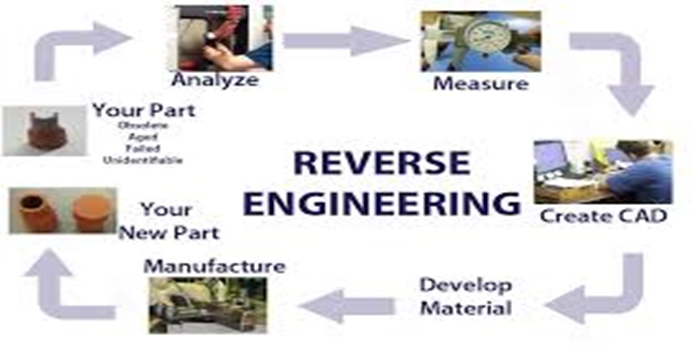In this article, we explained the meaning of reverse engineering, the types, the examples, we also talked the pros and cons.
Definition
Reverse Engineering is the process of studying another company’s product to see how it is made, sometimes in order to be able to copy it.
The Types of Reverse Engineering:
Hardware Reverse Engineering:
This involves disassembling a physical product to understand its components, circuitry, and how they interact. Common applications include creating digital twins of physical assets, adapting legacy systems, and developing non-destructive testing techniques.
Software Reverse Engineering:
This focuses on analyzing the code of a software application to understand its functionality, architecture, and potentially identify vulnerabilities. It can involve disassembling and decompiling binary code, as well as analyzing network traffic and API calls.
Biological Reverse Engineering:
This involves understanding the inner workings of biological systems by studying their physical and chemical properties. It can lead to the development of new drug therapies, diagnostic tools, and regenerative medicine techniques.
Specific Techniques:
Drawing and Scanning:
These are common methods in hardware reverse engineering to create CAD models of components for prototyping and manufacturing.
Disassembly:
This involves physically taking apart a component to study its internal workings.
3D Scanning:
This technology captures the shape and features of an object in digital form, which can then be used to create a CAD model.
CAD Modeling:
This process involves creating or modifying a 3D representation of an object.
Measurement Tools:
These tools, such as Coordinate Measuring Machines (CMMs), are used to verify the accuracy of reverse-engineered designs.
Disassembly and Analysis of Software:
This involves using specialized tools to disassemble and analyze binary code, identify algorithms and data structures, and understand the software’s functionality.
Network Analysis:
This involves capturing and analyzing network traffic to understand how a software application interacts with other systems.
API Monitoring:
This involves intercepting and analyzing API function calls to understand how a software application uses APIs.
Testing and Prototyping:
This involves creating a physical prototype of a reverse-engineered product to verify its design and identify any issues.
The Examples of Reverse Engineering:
Product Analysis and Improvement:
Reverse engineering can help engineers identify areas for improvement in existing products.
Studying Competitor Designs:
Reverse engineering can be used to analyze competitor products and understand their design choices.
Recovering Lost Designs or Documentation:
In cases where original designs or documentation are lost, reverse engineering can be used to recover them.
Identifying Security Vulnerabilities:
Reverse engineering can be used to identify security vulnerabilities in software and hardware.
Adapting Software to Different Architectures:
Reverse engineering can be used to adapt software designed for one platform to work on another.
Understanding How Software Performs Certain Operations:
Reverse engineering can be used to understand the specific algorithms and data structures used by a software application.
Fixing Bugs or Correcting Errors:
Reverse engineering can be used to identify and fix bugs in software, even when the source code is not available.
Creating 3D Models for Manufacturing:
Reverse engineering can be used to create 3D models of physical objects for manufacturing purposes.
Developing Non-Destructive Testing Techniques:
Reverse engineering can be used to develop new methods for testing and inspecting products without damaging them.
Integrating Legacy Systems:
Reverse engineering can be used to adapt legacy systems to work with modern digital infrastructure.
Digital Transformation:
Reverse engineering can be used to create digital twins of physical assets for simulation and analysis.
The Pros and Cons of Reverse Engineering:
Pros:
Improved understanding of products:
Reverse can help identify how a product functions, its design flaws, and areas for improvement.
Potential cost savings:
By analyzing existing products, reverse engineering can lead to cost reductions in areas like manufacturing or product development.
Enhanced product quality:
Reverse can reveal areas where products could be made more efficient or durable, leading to improved quality.
Increased flexibility:
Reverse can make it easier to repair, modify, or adapt products to specific needs.
Security analysis and ethical hacking:
Reverse engineering plays a vital role in identifying vulnerabilities in software and hardware, which is crucial for bolstering security.
Understanding of complex systems:
Reverse can be used to understand the logic and behavior of complex systems, even when documentation is incomplete or unavailable.
Cons:
Time-consuming and technically demanding:
Reverse can be a lengthy and challenging process, requiring significant technical expertise and resources.
Potential for errors and inaccuracies:
Reconstruction errors or misinterpretations can occur, especially when dealing with complex or poorly documented products.
Legal and ethical considerations:
Reverse can raise concerns regarding copyright, patents, and trade secrets, particularly when used for commercial purposes.
Risk of damage to products:
Reverse can sometimes damage or compromise the integrity of the product being analyzed.
Lack of access to documentation:
Reverse can be more difficult when access to the product’s original documentation is limited.
Potential for misuse:
Reverse can be used for malicious purposes, such as copying or replicating intellectual property.
Conclusion
Reverse engineering, in its simplest form, involves taking something apart to understand how it works. This could be a physical object, a software program, or even a biological system. Some examples of reverse engineering include analyzing competitors’ products to improve your own, replicating spare parts for discontinued vehicles, or studying the code of a program to fix bugs.


